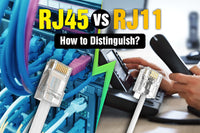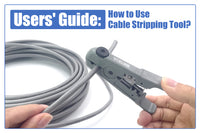Contents
Traditional telephones have been gradually replaced by smartphones in recent years, but landline phones remain prevalent in many households. Telephone cables play a vital role in connecting landline telephones and PCs to telecommunications, facilitating the transmission of sound and data across distances. This article will delve into everything about telephone cables and guide you in selecting the appropriate one.
What is Telephone Cable and What is it Used for?
The telephone cable is a copper cable that consists of several twisted wires. It is used to link telephone equipment to the public switched telephone network (PSTN) or private branch exchange (PBX), allowing people to make calls from one location to another. The telephone line transmits low voltage and low current signals between locations, functioning at frequencies below 300 kHz for voice signal transmission.
The primary purpose of telephone cables is to connect users and households to the telephone network. Additionally, they also provide Internet access through dial-up or digital subscriber line (DSL) connections and deliver data signals for security systems or medical equipment.
Telephone Cable Types
Telephone cables come in a variety of types, each designed for various functions and environments. Here are some of the most common types.
Outdoor vs Indoor Telephone Cables
Phone cables can be divided into outdoor and indoor types depending on the location of usage. Indoor or interior telephone cables are often flexible and easy to install, even in tight spots within your home. Outdoor or exterior telephone cables typically feature thicker, more durable jackets than indoor cables, providing enhanced resistance to moisture and temperature fluctuations.
Based on Telephone Cable Connectors
Telephone cables can also be categorized based on the type of telephone connector they use, such as 6P2C and 6P6C. Do you know what 6P6C means? “P” stands for positions and “C” refers to contacts, so a 6P6C connector has six positions and six contacts.
Modular connectors are standardized to the registered jack (RJ) interface, with RJ11, RJ12, and RJ14 as the most common telephone cable wiring.
The 6P4C connector is one of the most common modular connectors for connecting telephone devices, supporting both RJ11 and RJ14 wiring. A so-called RJ11 cable or 2-pair telephone cable typically has four copper wires terminating at the connector. Conventionally, the conductor colors of RJ11 cables are yellow, green, red, and black.
The RJ12 cable is an upgraded version of the RJ11 cable, using six copper wires. In contrast to 4-conductor telephone cables, 6-conductor cables can carry digital signals, facilitating connectivity to advanced telephone systems, supporting the complex functions of modern telephones, and transmitting higher-quality voice signals. It should be noted that RJ12 is backward compatible with RJ11.

Flat vs. Coiled vs. Round
- Flat Cable
Modular or flat telephone cables are usually used to connect telephone equipment to wall jacks in your home. The flat shape offers flexibility and convenience, making these telephone cables easy to route in tight places.
- Round Cable
Round telephone cables are traditional types consisting of several pairs of copper wires. Known for their robust construction, round cables are ideal for long-distance telephone installations and environments requiring a lot of telephone wires. These telephone cables are commonly used in large residential buildings and other large-scale outdoor installations.
- Coiled Cable
The coiled cord is made to connect the receiver to the telephone set base, allowing it to be stretched during use for flexibility. Coiled telephone cables typically use the smaller 4P4C modular connector, known informally as the RJ9 or RJ22 connector. Coiled phone cords are usually labeled with their total extension length. For example, a handset cord labeled as 12 feet measures about 2 feet in the unstretched state.
Telephone Cable Wiring
It is well known that Ethernet cables come in two types: straight-through and crossover. Similarly, telephone cables can be wired in two different ways: straight and reverse.
- Straight
Straight telephone cables have the same wiring diagram at both ends of the cable. Straight-through cords are mainly used for data transmission and serve devices like fax machines.
- Reverse
Unlike straight telephone cables, reverse telephone cables have reverse wiring at both ends. The reverse or crossover cords are used for voice transmission in telephone systems.

Other Common Cables for Telecommunications
Here are some other cables commonly used for telecommunications in your office or home:
- Ethernet Cables
Ethernet cables are often terminated with 8P8C (RJ45) connectors and can be categoried into Cat5, Cat5e, Cat6, Cat6a, Cat7, and Cat8. They can be shielded or unshielded. The unshielded type is commonly used in home or office environments, while the shielded type provides added protection from EMI and RFI and is suitable for environments with high levels of electrical noise. Primarily used for network transmission, Ethernet cables can also carry voice and digital signals for Integrated Services Digital Network (ISDN) services and transmit video signals in Voice over IP (VoIP) systems.
- Coaxial Cables
As transmission lines for high-frequency electrical signals, coaxial cables are often used in cable television, radio antennas, broadband internet access, and other applications. In the past, coaxial cables for long distances have also been used to build long-distance telephone networks.
- Fiber Optic Cables
Fiber optic cables are the medium for high-speed optical communications, popular in modern telecommunications and computer networking. Fiber optic cables can carry signals over long distances and are suitable for urban network connections and long-distance communications. They are indispensable in the global Internet infrastructure thanks to their high speed and capacity.
How to Install a 6P6C Connector on Telephone Cable?
Firstly, you should prepare the following materials: the telephone cable, wire jacket stripping tool, all-in-one crimper, cable snips, and 6P6C modular plugs.
Step 1: Use the stripping tool to strip the telephone cable jacket. Be careful not to damage the inner wires.

Step 2: Organize the wires in order and trim them evenly. Make sure the exposed wires are not longer than the connector length.

Step 3: Insert the wires into the 6P6C modular plug.

Step 4: Place the modular connector into the corresponding cavity of the all-in-one crimper and crimp it tightly. Make sure the wires make contact with connector contacts.

Step 5: The same operation on the other end of the telephone cable. If the telephone cable is used for voice transmission, adhere to the reverse wiring standard. However, for old fax machines, use the straight wiring standards.
Step 6: Use the tester to check whether the telephone cable works successfully.

Conclusion
Different phone cable types are required for signal transmission over short, medium, or long distances. For outdoor or underground installations, factors such as jacket thickness, moisture resistance, and operating temperature should be considered. In addition, different applications also require different telephone line cords. Understanding telephone cable types is vital for planning telephone infrastructure and home installation. Hopefully, this guide will assist you in your decision-making process.
For more information on this topic, you can keep up on our blogs. While VCELINK offers general and basic information for our customers and other visitors to the website, it’s not professional advice.



Be the first one to comment.
Leave a comment